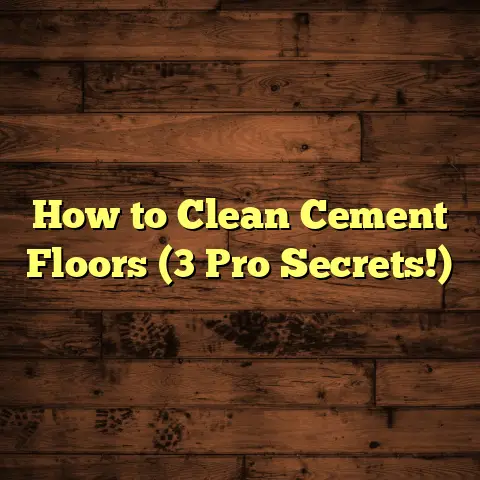Stop Squeaky Floating Floors Now! (2 Quick Fixes)
There’s nothing quite as annoying as a squeaky floor.
But it’s more than just an annoyance, especially if you’ve invested in eco-friendly flooring. It’s a sign that something isn’t quite right, and if left untreated, it could affect the longevity of your beautiful, sustainable investment.
Eco-Consciousness in Home Improvement
These days, we’re all becoming more aware of our impact on the planet, right? Sustainable living isn’t just a trend; it’s a necessary shift. We’re trying to reduce our environmental footprint in every way possible.
That’s why so many homeowners are choosing eco-friendly flooring options like bamboo, cork, and recycled materials.
I’ve seen a huge increase in demand for these materials, and it’s fantastic! According to a recent study by the National Association of Home Builders, over 60% of homeowners are now prioritizing eco-friendly options when renovating. (Source: National Association of Home Builders)
Choosing the right flooring material can contribute to a healthier planet and a healthier home. But here’s the thing: even the best eco-friendly floors can develop issues like squeaks. And I’m here to help you tackle them!
Think of it this way: maintaining your eco-friendly flooring is like taking care of a garden. You want to nurture it, protect it, and ensure it thrives.
So, let’s dive in and learn how to keep those eco-friendly investments in tip-top shape!
Section 1: Understanding Floating Floors
So, what exactly are floating floors?
Simply put, they’re flooring systems that aren’t nailed or glued to the subfloor. Instead, the planks or tiles interlock and “float” above the subfloor.
Think of it like a giant puzzle that fits together without any adhesive.
Construction and Installation
Floating floors typically consist of several layers:
-
Wear Layer: The top layer that you walk on,
usually made of a durable material like laminate,
vinyl, or wood veneer. -
Core Layer: The main structural component,
often made of high-density fiberboard (HDF) or
composite materials. -
Underlayment: A thin layer of foam or cork
attached to the bottom of the plank or installed
separately.
The installation process is pretty straightforward:
- Prepare the Subfloor: Ensure it’s clean,
level, and dry. - Install Underlayment: If it’s not already
attached to the planks. - Lay the First Row: Following the
manufacturer’s instructions. - Interlock the Planks: Using a tongue-and-groove
or click-lock system. - Leave Expansion Gaps: Around the perimeter of
the room to allow for movement.
Benefits of Eco-Friendly Floating Floors
Now, let’s talk about the good stuff! Eco-friendly floating floors offer a ton of benefits:
-
Sustainability: Materials like bamboo and cork
are rapidly renewable resources. Recycled materials
reduce waste and conserve resources. -
Easy Installation: Floating floors are DIY-friendly,
saving you money on installation costs. -
Comfort: The underlayment provides cushioning
and insulation, making your floors warmer and more
comfortable to walk on. -
Versatility: They can be installed over various
subfloors, including concrete, wood, and tile.
The Lightweight Challenge
One thing to keep in mind is that eco-friendly materials can sometimes be lighter than traditional flooring. This can be a good thing for installation, but it can also make them more susceptible to movement and, yes, squeaking.
The Mechanics of Expansion and Contraction
The key to understanding why floating floors squeak lies in their ability to expand and contract.
Since they’re not glued or nailed down, they need room to move with changes in humidity and temperature. This is where those expansion gaps come in.
However, if the gaps are too small, or if the subfloor isn’t perfectly level, the planks can rub against each other or against the subfloor, creating those annoying squeaks.
I remember one time, a client of mine had installed bamboo flooring in their sunroom. They loved the look, but within a few months, it started squeaking like crazy.
Turns out, they hadn’t left enough expansion space around the edges. The bamboo was expanding in the heat and rubbing against the walls. A simple fix, but a frustrating problem!
Section 2: Common Causes of Squeaks in Floating Floors
Alright, let’s get down to the nitty-gritty. What’s actually causing those squeaks?
Here are some of the most common culprits:
-
Improper Installation: This is a big one. If
the planks aren’t properly interlocked, or if the
subfloor isn’t level, you’re setting yourself up
for squeaks. -
Gaps Between Planks: Even small gaps can allow
the planks to move and rub against each other. -
Humidity and Temperature Changes: Wood and
other natural materials expand and contract with
changes in humidity and temperature. This can cause
the planks to shift and squeak. -
Inadequate Underlayment: The underlayment is
there to provide cushioning and reduce noise. If
it’s too thin or compressed, it won’t do its job
properly. -
Subfloor Issues: An uneven or damaged subfloor
can cause the floating floor to flex and squeak.
Practical Examples
Let’s break it down with some real-life scenarios:
-
The Case of the Uneven Subfloor: I once worked
on a house where the subfloor had a noticeable dip
in the middle of the living room. The homeowners
installed a beautiful cork floating floor, but every
time you walked across that area, it sounded like a
flock of mice were having a party. The solution?
We had to level the subfloor before reinstalling the
flooring. -
The Mystery of the Missing Underlayment: Another
time, a client called me complaining about a
squeaky laminate floor. When I pulled up a section
of the flooring, I discovered that the original
installer had completely skipped the underlayment in
some areas! No wonder it was squeaking.
Impact on Your Living Space
Squeaky floors aren’t just annoying; they can also impact your quality of life.
Imagine trying to relax in your living room, but all you hear is “squeak, squeak, squeak” every time someone walks by. It can be incredibly distracting and stressful.
Plus, if you’re trying to sell your home, squeaky floors can be a major turnoff for potential buyers.
Section 3: Quick Fix #1: Lubrication Techniques
Alright, let’s get to the good stuff! Here’s the first quick fix: lubrication.
This works best when the squeaks are caused by the planks rubbing against each other.
Step-by-Step Guide to Identifying Squeaky Spots
-
Walk Around: Carefully walk around the room,
paying attention to where the squeaks are coming
from. -
Mark the Spots: Use painter’s tape to mark the
exact location of each squeak. -
Apply Pressure: Gently apply pressure to the
area around the squeak to see if you can pinpoint
the source.
Eco-Friendly Lubricants
Now, for the fun part! Here are some eco-friendly lubricants that you can use to silence those squeaks:
-
Vegetable Oil: A simple and readily available
option. Just be careful not to use too much, as it
can attract dust and dirt. -
Beeswax: A natural and non-toxic lubricant that
works great on wood floors. You can find beeswax
sticks or pellets at most hardware stores. -
Soapstone Powder: A fine powder that can be
used to lubricate the joints between planks.
I personally prefer beeswax because it’s natural, effective, and doesn’t leave a greasy residue.
Application Process
-
Clean the Area: Use a damp cloth to clean the
area around the squeak. -
Apply the Lubricant: For vegetable oil, use a
small dropper or syringe to apply a few drops into
the gap between the planks. For beeswax, rub the
stick along the joint. For soapstone powder, sprinkle
a small amount into the gap. -
Work It In: Gently walk over the area to work
the lubricant into the joint. -
Wipe Away Excess: Use a clean cloth to wipe
away any excess lubricant.
Testing for Effectiveness
After applying the lubricant, walk over the area again to see if the squeak is gone. If not, repeat the process until the squeak disappears.
Long-Lasting Tips
To ensure that the fix is long-lasting, try these tips:
-
Maintain Consistent Humidity: Use a humidifier
or dehumidifier to keep the humidity levels in your
home consistent. -
Avoid Excessive Moisture: Clean up spills
immediately and avoid using excessive water when
cleaning your floors. -
Regularly Inspect Your Floors: Check for gaps
or loose planks and address them promptly.
I had a client who was skeptical about using vegetable oil on their squeaky bamboo floor. They were worried about it attracting bugs or leaving a stain.
But after trying it, they were amazed at how well it worked! The squeak was gone, and they didn’t have any issues with bugs or staining.
Section 4: Quick Fix #2: Underlayment Adjustments
Okay, let’s move on to the second quick fix: adjusting or upgrading the underlayment.
This is a great option if the squeaks are caused by the subfloor or by an inadequate underlayment.
The Role of Underlayment
The underlayment plays a crucial role in the performance of floating floors. It provides:
-
Cushioning: Absorbing impact and making the
floor more comfortable to walk on. -
Noise Reduction: Reducing noise transmission
between floors. -
Insulation: Providing thermal insulation and
reducing energy costs. -
Moisture Barrier: Protecting the flooring from
moisture damage.
Assessing Your Current Underlayment
To determine if the underlayment is the source of the squeaking, try this:
-
Lift a Section of Flooring: Carefully remove a
section of the flooring near the squeaky area. -
Inspect the Underlayment: Check for signs of
wear, compression, or damage. -
Test the Cushioning: Press down on the
underlayment to see if it provides adequate
cushioning.
If the underlayment is thin, compressed, or damaged, it’s time for an upgrade!
Eco-Friendly Underlayment Options
Fortunately, there are plenty of eco-friendly underlayment options available:
-
Cork Underlayment: Made from the bark of cork
trees, a renewable resource. It provides excellent
cushioning, noise reduction, and insulation. -
Recycled Rubber Underlayment: Made from recycled
tires or other rubber products. It’s durable,
water-resistant, and provides good noise reduction. -
Wool Underlayment: Made from natural wool fibers.
It’s soft, comfortable, and provides good insulation.
I’m a big fan of cork underlayment because it’s natural, sustainable, and performs really well.
Installation Guide
-
Remove the Old Underlayment: Carefully remove
the old underlayment, making sure to clean the
subfloor thoroughly. -
Cut the New Underlayment: Use a utility knife
to cut the new underlayment to the correct size. -
Install the Underlayment: Roll out the
underlayment and secure it to the subfloor with
tape or adhesive, if necessary. -
Reinstall the Flooring: Carefully reinstall the
flooring, making sure to interlock the planks
properly.
Sustainability and Effectiveness
When choosing an underlayment, look for products that are certified by organizations like the Forest Stewardship Council (FSC) or the Greenguard Environmental Institute.
These certifications ensure that the products meet strict environmental standards.
I had a client who replaced their old, compressed underlayment with a new cork underlayment. They were amazed at the difference it made!
Not only did it eliminate the squeaks, but it also made their floors warmer and more comfortable to walk on.
Section 5: Embracing Sustainable Home Solutions
So, there you have it! Two quick fixes for squeaky floating floors that are both effective and eco-friendly.
Addressing squeaky floors isn’t just about comfort and peace of mind; it’s also about taking care of your investment and embracing sustainable living.
By implementing these quick fixes, you can enjoy a quieter, more sustainable living environment while also protecting your eco-friendly investments.
I encourage you to take proactive steps in maintaining your flooring and to consider the long-term benefits of your choices.
Remember, every little bit helps when it comes to reducing our environmental footprint. And by choosing eco-friendly flooring and maintaining it properly, you’re making a positive impact on the planet.
So, go ahead and tackle those squeaks! Your ears (and the planet) will thank you.
If you have any questions or need further assistance, don’t hesitate to reach out to a qualified flooring contractor. We’re here to help!





